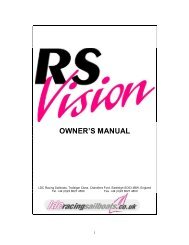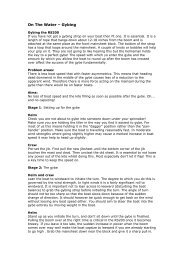rs200 owner's manual - Rs Sailing
rs200 owner's manual - Rs Sailing
rs200 owner's manual - Rs Sailing
Create successful ePaper yourself
Turn your PDF publications into a flip-book with our unique Google optimized e-Paper software.
Racing the RS200<br />
Upwind<br />
Under 6knots: In this sub hiking wind it pays to control the mainsail leech using th<br />
mainsheet only. In this breeze, the jib generally has to be played, often with the sheet<br />
slightly eased to maintain speed through the water.<br />
The outhaul should be falling off the boom, creating approximately a 2" gap between<br />
the boom and the foot of the sail at it's mid point.<br />
It is important to get the crew weight as far forward as possible, with the crew being<br />
located in the vicinity of the jib cleats and the helm in front of the main sheet.<br />
6-15 knots: Once hiking, increase the rig tension as out-lined above, the jib can then<br />
be sheeted fairly hard to generate pointing. Try and maintain mainsail leech tension<br />
with the mainsheet for as long as possible, but as soon as the boom has to be eased,<br />
the leech tension will have to be held by the vang. Once vang is required, it pays to<br />
"pull it on hard!". This is due to there only being an 8:1 vang allowed by the class<br />
rules and the significant tension required to close in the large roached mainsail.<br />
The outhaul should remain eased untl overpowered, when it should be pulled on until<br />
the foot of the sail touches the boom.<br />
Once the mainsheet is permanently eased (over 12 knots), the cunninghamshould be<br />
used to remove the horizontal creases that would have appeared on the luff edge of<br />
the mainsail.<br />
Over 15 knots: The rig should now be raked back, with large amounts of vang,<br />
cunningham and outhaul tension. The boat can now be "feathered" easily, constantly<br />
playing hthe mainsheet over the leeward aft quarter of the boat.<br />
When you are overpowered, it does not pay to reduce rig tension in an attempt to<br />
increase rake and depower.<br />
Downwind Sail Settings<br />
Under 6 knots: Unlike most assymetric boats, it seems the helm must sit to leeward<br />
and the crew to windward, both as far forward as possible. The outhaul can be<br />
eased 6" away from the boom and when trying to run deep, the centreboard can be<br />
raised halfway.<br />
6-15 knots: The helm should stay to leeward until the boat is almost planing / surfing<br />
when the crew should move onto the thwart and the helm onto the windward side to<br />
increase control. The outhaul and the cunningham should remain eased. The RS200<br />
is particularly responsive to being steered and pumped through waves to induce the<br />
surf / plane. The centreboard should be lowered to increase stability.<br />
When reaching, always try to maintain vang tension to keep the boat in balance.<br />
Over 15 knots: The helm must be to windward with the centreboard fully down. It<br />
can pay to have the crew on the windward side as well, even if trying to run deep.<br />
Gybing in these conditions often requires a gybing strop on the boom.<br />
When reaching it pays to sit well aft in the boat. If overpowered, ease the spinnaker<br />
sheet allowing the kite to permanently curl (this takes alot of concentration by the<br />
crew) and pull on the outhaul and the cunningham, only easing the vang as a very<br />
last resort as this makes the boat unstable.<br />
22




